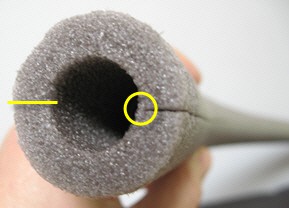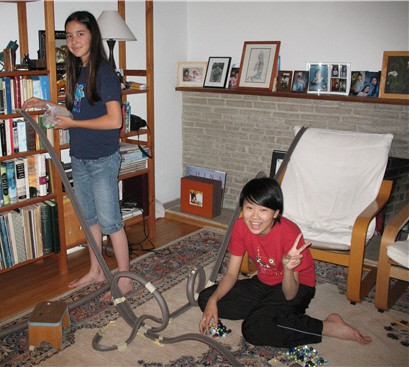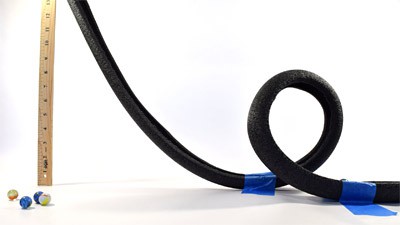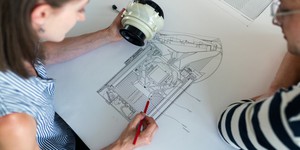Abstract
If you'd like to investigate the physics of amusement park rides, then this project is for you. You'll build a roller coaster track for marbles using foam pipe insulation and masking tape, and see how much the marble's potential energy at the beginning of the track is converted to kinetic energy at various points along the track.Summary
Andrew Olson, Ph.D., Science Buddies
Objective
The goal of this project is to build a roller coaster for marbles using foam pipe insulation and to investigate how much of the gravitational potential energy of a marble at the starting point is converted to the kinetic energy of the marble at various points along the track.
Introduction
Slow and clanking, the string of cars is pulled up to the crest of the tallest point on the roller coaster. One by one, the cars start downhill on the other side, until gravity takes over and the full weight of the train is careening down into curves, twists, and turns. The roller coaster is a great example of conversions between potential energy (stored energy) and kinetic energy (the energy of motion). As the cars are being pulled up to the top of the first hill, they are acquiring potential energy. The chain that pulls them up the hill works against the force of gravity. At the top of the hill, the cars' potential energy is at it's maximum. When the cars start down the other side, this potential energy is converted to kinetic energy. The cars pick up speed as they go downhill. As the cars go through the next uphill section, they slow down. Some of the kinetic energy is now being converted to potential energy, which will be be released when the cars go down the other side.
Potential energy comes in many forms. For example, chemical energy can be stored and later converted into heat or electricity. In the case of a roller coaster, the stored energy is called "gravitational potential energy," since it is the force of gravity that will convert the potential energy into other forms. The amount of gravitational energy can be calculated from the mass of the object (m, in kg), the height of the object (h, in m), and the gravitational constant (g = 9.8 m/s2). The equation is simply: gravitational potential energy = mgh.
Kinetic energy is the energy of motion. The amount of kinetic energy an object has is determined by both the mass of the object and the velocity at which it is moving. The equation for calculating kinetic energy is: kinetic energy = 1/2 mv2, where m is the mass of the object (in kg) and v is the velocity of the object (in m/s).
You've probably noticed that the first hill on the roller coaster is always the highest (unless the coaster is given another "boost" of energy along the way). This is because not all of the potential energy is converted to kinetic energy. Some of the potential energy is "lost" in other energy conversion processes. For example, the friction of the wheels and other moving parts converts some of the energy to heat. The cars also make noise as they move on the tracks, so some of the energy is dissipated as sound. The cars also cause the supporting structure to flex, bend, and vibrate. This is motion, so it is kinetic energy, but of the track, not the cars. Because some of the potential energy is dissipated to friction, sound, and vibration of the track, the cars cannot possibly have enough kinetic energy to climb back up a hill that is equal in height to the first one. The way that physicists describe this situation is to say that energy is conserved in a closed system like a roller coaster. That is, energy is neither created nor destroyed; there is a balance between energy inputs to the system (raising the train to the top of the initial hill) and energy outputs from the system (the motion of the train, its sound, frictional heating of moving parts, flexing and bending of the track structure, and so on).
You can investigate the conversion of potential energy to kinetic energy with this project. You'll use foam pipe insulation (available at your local hardware store) to make a roller coaster track. For the roller coaster itself, you'll use marbles. By interrupting the track and allowing the marble to continue on a smooth, level surface, you'll measure the velocity of the marble at different points along the track. From the velocity and the mass of the marble, you'll be able to calculate the marble's kinetic energy at the different track locations.
For each track configuration, you should try at least 10 separate tests with the marble to measure the kinetic energy. How much of the marble's gravitational potential energy will be converted to kinetic energy? A foam roller coaster for marbles is easy to build, so try it for yourself and find out!
Terms and Concepts
To do this project, you should do research that enables you to understand the following terms and concepts:
- Potential energy (stored energy)
- Kinetic energy (energy of motion)
- Conservation of energy (basic law of physics)
- Gravity
- Velocity
- Friction
- Slope (rise/run)
Questions
- What is the equation for calculating an object's gravitational potential energy?
- What is the equation for calculating an object's kinetic energy?
- The marble has its maximum gravitational potential energy when it is at the starting point: the highest point on the roller coaster. How much of this potential energy is converted to the marble's kinetic energy?
Bibliography
- This short animation explains kinetic energy and potential energy:
Brain POP Staff. (n.d.). Kinetic Energy. Brain POP Animated Educational Site for Kids. Retrieved August 23, 2007. - Here are some more quantitative explanations of kinetic and potential energy:
- Henderson, T. (n.d.). Work, Energy, and Power. The Physics Classroom and Mathsoft Engineering & Education, Inc. Retrieved August 23, 2007.
- Nave, C.R. (n.d.). Kinetic Energy. HyperPhysics, Department of Physics and Astronomy, Georgia State University. Retrieved August 23, 2007.
- Nave, C.R. (n.d.). Potential Energy. HyperPhysics, Department of Physics and Astronomy, Georgia State University. Retrieved August 23, 2007.
Materials and Equipment
To do this experiment you will need the following materials and equipment:
- At least two 6 foot (183 cm) sections of 1-1/2 in (about 4 cm) diameter foam pipe insulation
- Glass marbles
- Utility knife
- Masking tape
- Tape measure
- Bookshelf, table, or other support for roller coaster starting point
- Stopwatch
- Gram scale for weighing marble, such as the digital pocket scale from Amazon.com
- Length of Masonite (smooth hardboard) for marble to travel on (for measuring velocity at different points along the track). You can glue the Masonite into a V-shape, and paint it with alternating stripes at 5 or 10 cm intervals. The V-shape keeps the marble going straight, and the stripes allow you to easily measure the distance the marble has traveled during a timed interval.
- Optional: video camera and tripod
Disclaimer: Science Buddies participates in affiliate programs with Home Science Tools, Amazon.com, Carolina Biological, and Jameco Electronics. Proceeds from the affiliate programs help support Science Buddies, a 501(c)(3) public charity, and keep our resources free for everyone. Our top priority is student learning. If you have any comments (positive or negative) related to purchases you've made for science projects from recommendations on our site, please let us know. Write to us at scibuddy@sciencebuddies.org.
Experimental Procedure
Note: Use the utility knife with care. A fresh, sharp blade will make cutting the insulation easier.
- Do your background research so that you are knowledgeable about the terms, concepts, and questions, above.
-
Cut the foam pipe insulation in half (the long way) to make two U-shaped channels.
-
The illustration below shows the foam pipe insulation, end-on.

Figure 1. The illustration above shows the cross-section at one end of the foam pipe insulation
- The insulation comes with one partial cut along the entire length. Complete this cut with the utility knife (yellow circle in the illustration above).
- Make a second cut on the other side of the tube (yellow line in the illustration above), along the entire length of the tube.
- You'll end up with two separate U-channel foam pieces. You can use masking tape to attach pieces end-to-end to make the roller coaster track as long as you want.
-
The illustration below shows the foam pipe insulation, end-on.
- To make a roller coaster track, tape two (or more) lengths of the foam U-channel together, end-to-end. The joint between the two pieces should be as smooth as possible.
-
You can make the track as simple or as complex as you'd like. You can add curves, loops, and additional uphill and downhill sections. The illustration below shows two examples. You'll find that one requirement is that the starting point be the highest point on the track.

Figure 2. The illustration above shows two different roller coaster tracks for marbles. How much height is needed at the starting point in order for the marble to loop the loop?
-
In order to measure the velocity of the marble, you'll need a way to measure how much distance the marble travels during a measured time interval.
- A good way to do this is to interrupt the foam track and direct the marble along a smooth, level surface (e.g., two long pieces of Masonite glued in a V-shape). Support the Masonite V (with cardboard, beanbags, etc.) so that it is level with the end of the foam track.
- Paint the Masonite with 5 or 10 cm long stripes in contrasting colors (e.g., red and white or black and white) so that you can use it to measure distances.
- Use the stopwatch to measure the time it takes for the marble to travel a certain length along the Masonite track.
- You can also videotape the marble, and use the measuring stick to measure the distance the marble travels in successive frames (each standard video frame is 1/30 second).
- Measure the height of the starting point for the track.
- Measure the mass of the marble.
- Calculate the gravitational potential energy of the marble at the starting point.
-
Run a single marble down the track 10 separate times.
- For each run, use your striped measuring stick and stopwatch to measure the velocity of the marble as it completes the track.
- Calculate the average of your 10 measurements.
- More advanced students should also calculate the standard deviation.
- From your velocity measurement and the mass of the marble, calculate the kinetic energy of the marble.
- Repeat the velocity measurement at various points on the track by cutting the track and allowing the marble to continue on in a straight line on a smooth surface. Use your striped measuring stick and stopwatch to measure the velocity of the marble.
- Does the marble's kinetic energy ever equal or exceed its initial gravitational potential energy?
Ask an Expert
Global Connections
The United Nations Sustainable Development Goals (UNSDGs) are a blueprint to achieve a better and more sustainable future for all.
Variations
Here are just a few of many possible variations on this project. Perhaps these will stimulate your thoughts about other experiments you could try:
- How much kinetic energy is required for various track features? For example, how much kinetic energy is required for a marble to successfully navigate a loop in the track?
- You can expand the experiment by building a set of roller coaster tracks with various loop sizes. How does the kinetic energy requirement change when the loop diameter increases? How does the kinetic energy requirement change when the loop diameter decreases?
- If you can find spheres that have equal diameter but made from different materials, you could investigate how the mass of the sphere affects how well it travels along the track.
- Maybe you noticed that your loop wobbles a bit as your marble passes through it. The energy to move the track comes from the marble. The energy that the marble loses to make the track move means less energy is available to make the marble itself move. Can you think of a way to stabilize the loop so that it doesn't wobble? Does the marble have more kinetic energy after exiting the stabilized loop? Design an experiment to find out!
- Try using different lengths of roller coaster track so that you can adjust the initial slope of the track. Keep the starting height the same, but change the slope by adding additional track length. (Remember, slope is rise/run, so you'll be holding the "rise" constant, and gradually increasing the "run.") How do you think the kinetic energy of the marble will change as you change the slope of the track?
- For a more basic version of this experiment, see the Science Buddies project Marble Roller Coaster: How Much Height to Loop the Loop?.
- Can you use software to make a physics simulation of your ball launcher? Check out the project The Physics of Simulation vs Reality.
Careers
If you like this project, you might enjoy exploring these related careers:












